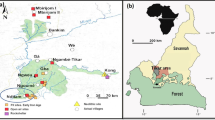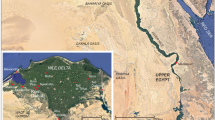Abstract
Ceramic kilns are an indispensable part of the study of ceramic technology. Studies on the construction and maintenance of ancient ceramic kilns are mostly based on field observations during excavation. Here we report on the micromorphological study of a Late Helladic updraft ceramic kiln from the archeological site of Kolonna, Aegina Island, Greece. The study is focused on the construction details and stratigraphy of the interior of the kiln and also on the ashy sediments of the entrance area with the aim to better understand the operation of the kiln. In addition, X-ray power diffraction (XRPD), Fourier transform infrared (FTIR) spectroscopy, and FTIR microspectroscopy, applied directly on thin sections, provided information on the temperature of firing and on the observed mineralogical transformations. A highly calcareous clay was used for the construction of the kiln. The main construction of the kiln was followed by two major reconstructions affecting both the walls and floor, but not the door area. In between the reconstruction phases, the kiln was left open for considerable periods, probably during the rainy seasons as attested by the preservation of water-lain sedimentary crusts on the floor of the kiln. The firing process formed a poreless, well-reacted sealing crust on the inner surfaces of the kiln which presumably acted as an insulating shell. Calcitic ashes have been transformed to quicklime and hard indurated surfaces resembling lime constructions. The mineralogical transformations suggest firing temperatures in excess of 700 °C but probably lower than 900 °C. The use of highly calcareous material for the construction of the kiln, generally considered not suitable for its inferior thermal insulating properties and strength, is discussed in the light of the observed mineralogical transformations and fabric.



















Similar content being viewed by others
References
Berna F (2017) FTIR microscopy. In: Nicosia C, Stoops G (eds) Archaeological soil and sediment micromorphology. Wiley Blackwell, London, pp 411–415
Berna F, Behar A, Shahack-Gross R, Berg J, Boaretto E, Gilboa A, Sharon I, Shalev S, Shilstein S, Yahalom-Mack N, Zorn JR, Weiner S, (2007) Sediments exposed to high temperatures: reconstructing pyrotechnological processes in Late Bronze and Iron Age Strata at Tel Dor (Israel). Journal of Archaeological Science 34 (3):358–373
Berna F, Goldberg P (2007) Assessing Paleolithic pyrotechnology and associated hominin behavior in Israel. Isr J Earth Sci 56:107–121
Canti MG (2003) Aspects of the chemical and microscopic characteristics of plant ashes found in archaeological soils. Catena 54:339–361
Courty MA, Goldberg P, Macphail R (1989) Soils and micromorphology in archaeology. Cambridge University Press, Cambridge
Cultrone G, Rodriquez-Navarro C, Sebastian E, Cazalla O, De La Torre MJ (2001) Carbonate and silicate phase reactions during ceramic firing. Eur J Mineral 13:621–634
Dufay B, Barat Y, Raux S (1997) Fabriquer de la veissell á l’epoque romaine. Archéologie d’un centre de production en Gaule, La Boissiére-Ecole (Yvelines). Versilles: counseil général des Yvellines, Service archeologique départmenal des Yvelines
Farmer VC (1974) The infrared spectra of minerals. Mineralogical Society Monograph, London
Felten F, Hiller S, Reinholdt C, Gauß W, Smetana R (2004) Ägina-Kolonna 2003. Vorbericht über die Grabungen des Instituts für Klassische Archäologie der Universität Salzburg. ÖJh 73:97–128
Forget MCL, Regev L, Friesem DE, Shahack-Gross R (2015) Physical and mineralogical properties of experimentally heated chaff-tempered mud bricks: implications for reconstruction of environmental factors influencing the appearance of mud bricks in archaeological conflagration events. J Archaeol Sci Rep 2:80–93
Gauß W (2007) Ägina Kolonna in frühmykenischer Zeit. In: Alram-Stern E, Nightingale G, Bächle AE (eds) Keimelion. Elitenbildung und elitärer Konsum von der mykenischen Palastzeit bis zur Homerischen Epoche: Akten des internationalen Kongresses vom 3. bis 5. Februar 2005 in Salzburg = The Formation of Elites and Elitist Lifestyles from Mycenaean Palatial Times to the Homeric Period. Verlag der Österreichischen Akademie der Wissenschaften, Wien, pp 163–172
Gauß W (2010) Aegina Kolonna. In: Cline EH (ed) The Oxford Handbook of the Bronze Age Aegean (ca. 3000–1000 BC). Oxford University Press, Oxford, pp 737–751
Gauß W, Kiriatzi E (2011) Pottery production and supply at Bronze Age Kolonna, Aegina. An integrated archaeological and scientific study of a ceramic landscape. Contributions to the chronology of the Eastern Mediterranean, XXVII. Verlag der Österreichischen Akademie der Wissenschaften, Wien
Gauß W, Lindblom M, Smetana R (2011) The middle Helladic large building complex at Kolonna. A preliminary view. In: Gauß W, Lindblom M, Smith RAK, Wright JC (eds) our cups are full: pottery and Society in the Aegean Bronze Age. Papers presented to Jeremy B. Rutter on the occasion of his 65th birthday. Archaeopress, Oxford, pp 76–87
Gualtieri ML, Gualtieri AF, Gagliardi S, Ruffini P, Ferrari R, Hanuskova M (2010) Thermal conductivity of fired clays: effects of mineralogical and physical properties of the raw materials. Appl Clay Sci 49:269–275
Hansen Streily A (2000a) Bronzezeitliche Töpferwerkstätten in der Ägäis und in Westanatolien. Dissertation, Universität Mannheim. http://madoc.bib.uni-mannheim.de/madoc/volltexte/2005/1133/pdf/Hansen_streily1.pdf
Hansen Streily A (2000b) Early pottery kilns in the Middle East. Paleorient 26:69–81
Hasaki E (2002) Ceramic kilns in Ancient Greece: technology and Organization of Ceramic Workshops. Dissertation, University of Cincinnati
Kardos J, Zimmer K, Krisont L, Morozova O, Träger T, Jerem E (1985) Scientific investigations of the Sopron-Krautacker Iron Age pottery workshop. Archaeometry 27:83–93
Karkanas P (2007) Identification of lime plaster in prehistory using petrographic methods: a review and reconsideration of the data on the basis of experimental and case studies. Geoarchaeology 22:775–795
Kristály F, Kelemen É, Rózsa P, Nyilas I, Papp I (2012) Mineralogical investigations of Medieval brick samples from Békés county (SE Hungary). Archaeometry 54:250–266
Liritzis Y, Thomas R (1980) Paleointensity and thermoluminescence measurements on Cretan kilns from 2000 to 1300 B.C. Nature 283:54–55
Manning SW (2010) Chronology and terminology. In: Cline EH (ed) The Oxford Handbook of the Bronze Age Aegean (ca. 3000–1000 BC). Oxford University Press, Oxford, pp 11–28
Mentesana R, Kilikoglou V, Todaro S, Day PM (2019) Reconstructing change in firing technology during the final Neolithic–Early Bronze Age transition in Phaistos, Crete. Just the tip of the iceberg? Archaeol Anthropol Sci 11:871–894
Pagliai M, Stoops, G (2010). Physical and biological crusts and seals. In: Stooops G, Eswaran, H (eds), Marcelino Arecelino V, Mees F (co-eds) Micromorpholgogical Features of Soils and Regoliths. Their Relevance for Pedogenic Studies and Classifications. Elsevier, Amsterdam, pp 521–541
Regev, L, Poduska, KM, Addadi, L, Weiner, S, Boaretto, E (2010) Distinguishing between calcites formed by different mechanisms using infrared spectrometry: archaeological applications: Journal of Archaeological Science 37, 3022–3029
Rutter JB (1993) Review of Aegean prehistory II: the Prepalatial Bronze Age of the southern and central Greek mainland. AJA 97(4):745–797
Shaw JW, van de Moortel A, Day PM, Kilikoglou V (2001) A LM Ia ceramic kiln in south-Central Crete. Hesperia Supplement 30
Shoval S (1988) Mineralogical changes upon heating calcitic and dolomitic marl rocks. Thermochim Acta 35:243–252
Shoval S (1993) The burning temperature of a Persian-period pottery kiln at Tel Michal, Israel, estimated form the composition of slag-like material formed in its wall. J Therm Anal 39:1157–1168
Shoval S, Erez Z, Kirsh Y, Deutsch Y, Kochavi M, Yadin E (1989) Determination of the intensity of an early iron age conflagration at Tel-Hadar, Israel. Thermochim Acta 148:485–492
Shoval S, Yadin E, Panczer G (2011) Analysis of thermal phases in calcareous Iron Age pottery using FT-IR and Raman spectroscopy. J Therm Anal Calorim 104:515–525
Stoops G (2003) Guidelines for analysis and description of soil regolith thin sections. Soil Science Society of America, Madison, Wisconsin
Thér R (2014) Identification of pottery firing structures using the thermal characteristics of firing. Archaeometry 56:78–99
Trindade MJ, Dias MI, Coroado J, Rocha F (2009) Mineralogical transformations of calcareous rich clays with firing: a comparative study between calcite and dolomite rich clays from Algarve, Portugal. Appl Clay Sci 42:345–355
Villagran XS, Balbo AL, Madella M, Vila A, Estevez J (2011) Experimental micromorphology in Tierra del Fuego (Argentina): building a reference collection for the study of shell middens in cold climates. JAS 38:588–604
Walter H (2001)Die Leute von Alt-Ägina 3000-1000 v.Chr. Βιβλιοθήκη της εν Αθήναις Αρχαιολογικής Εταιρείας, vol 204. Αρχαιολογική Εταιρεία, Athen
Weiner S (2010) Microaerchaeology: beyond the visible archaeological record. Cambridge University Press, Cambridge
Yoshioka S, Kitano Y (1985) Transformation of aragonite to calcite through heating. Geochem J 19:245–249
Acknowledgments
We thank Yiannis Mitsis of Economic Geology and Geochemistry Laboratory (Department of Geology and Geoenvironment) of National and Kapodistrian University of Athens for conducting the XRPD spectra of the study. We also thank Dimitris Roussos for contributing to the XRD analysis of the samples. We appreciate the constructive comments of two anonymous reviewers.
Author information
Authors and Affiliations
Corresponding author
Additional information
Publisher’s note
Springer Nature remains neutral with regard to jurisdictional claims in published maps and institutional affiliations.
Rights and permissions
About this article
Cite this article
Karkanas, P., Berna, F., Fallu, D. et al. Microstratigraphic and mineralogical study of a Late Bronze Age updraft pottery kiln, Kolonna site, Aegina Island, Greece. Archaeol Anthropol Sci 11, 5763–5780 (2019). https://doi.org/10.1007/s12520-019-00903-7
Received:
Accepted:
Published:
Issue Date:
DOI: https://doi.org/10.1007/s12520-019-00903-7




